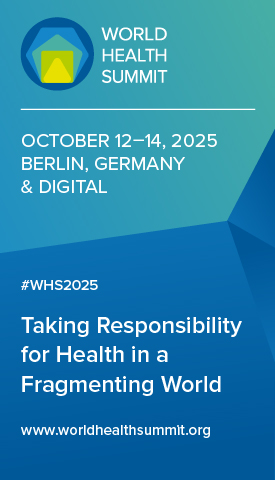Curing vulnerabilities
A multitude of high-consequence shocks threaten the world’s health systems, and time is running out to build in resilience that protects systems and the lives that rely on them
Covid-19 has highlighted the need for more resilient health systems. What does ‘resilient health systems’ mean?
Health systems are vulnerable to a multitude of high-consequence shocks – not only pandemics, but also climate change, ageing, cyberattacks, war and many more. The notion of resilience refers to how complex systems, such as health systems, operate under stress and emphasises the need to prepare for and recover from shocks. It recognises the interdependencies within and beyond the health system – health supply chains, social care, the wider health innovation ecosystem – and promotes the design of systems capable of providing high-quality care under extreme stress.
Resilient health systems save lives and protect against disruptions that have major socio-economic consequences. Without resilience, health systems will fail under pressure, initially containable problems become larger, threatening the health of populations, economic security and societal well-being. Resilient health systems are a buttress to disruption and recover more quickly. They have the workforce, the physical resources, the data and information technology systems, leadership and coordination mechanisms necessary to respond to new and changing circumstances.
The Covid-19 pandemic has dramatically shown how health systems are not as resilient as they ought to be. Most countries lacked spare capacity, especially in the workforce, with nearly four-fifths of the members of the Organisation for Economic Co-operation and Development reporting the number of hospital nurses to be an issue. Only one-fifth of OECD countries had real-time data about the health system at the start of the pandemic, which limited their responsiveness. Well-functioning health systems rely on other areas of society and economy. One salient example is supply chains. Two-thirds of OECD countries reported supply chain difficulties and almost all (92%) had difficulty obtaining personal protective equipment. A gold-plated pandemic preparedness and response system will not be enough if the underpinning health systems are not fit for purpose. Improving the resilience of health systems involves addressing problems holistically.
How has Covid-19 affected vulnerable groups? What policy actions are needed to ensure equity in resilient health systems?
Vulnerable populations – poor and disadvantaged people – have borne a disproportionate burden from the pandemic. Several instances come to mind:
Socially disadvantaged groups and ethnic minorities have faced an elevated risk of infection, severe illness and death from the virus. Mortality data from 13 OECD countries show an 80% increase in the relative risk of dying for those living in the most deprived areas in the first year of the pandemic. Black and Hispanic ethnic minorities were also at least twice as likely as white people to die from Covid-19 in the United Kingdom and the United States.
Socially disadvantaged groups have foregone care and experienced disruption in routine care and mental distress associated with the pandemic and lockdown measures.
The prevalence of depression was more than twice as high among people with lower incomes than people with higher incomes in Austria, Canada, the Czech Republic, France and the United States, to mention a few.
Achieving equity in the context of a high- impact shock such as a pandemic requires resilience, at least in three dimensions.
First, the resilience of populations needs to be improved through better investment in public health and prevention. The high prevalence of chronic diseases was a contributing factor to Covid-19 mortality rates. More than a third of the population in OECD countries had a long-standing illness before the pandemic, reaching 43% in the poorest income quintile of the population, compared to 24% for the richest income quintile. Yet still only less than 3% of total health spending went to prevention and public health in 2020 across OECD countries.
Second, primary healthcare services must be reinforced to reach the most disadvantaged populations and maintain care continuity during a crisis. Only 15 OECD countries were able to deploy mobile primary healthcare units to ease access to primary health care in underserved or deprived areas. In nearly half of OECD countries, community pharmacists took on roles traditionally reserved for doctors, maintaining access to care and reducing inequities.
Third, many interrelated causes of social gradient must be addressed: increased exposure through working and living conditions that are worse for vulnerable and poor populations, inequities in health conditions and risk factors, such as diabetes or obesity, linked to poor lifestyles and poverty, and wider socio-economic barriers to access and use of health care.
Can we achieve more resilient health systems without further investment?
The pandemic has demonstrated that when health systems are not strong enough to respond to major unexpected shocks, the cascading health and economic consequences are devastating. So yes, we do need to invest more to reinforce the ability and agility of health systems to respond to shocks.
Targeted investments are crucial in at least three main areas:
First, as mentioned, we need to protect people’s underlying health, through better prevention and public health. This reinforces population defences in times of shock and stress and reduces pressures on health systems.
Second, we need to invest in the front lines of health systems, by building and maintaining sufficient numbers of doctors and nurses. Workforce deficiencies have been the most binding constraint during the pandemic.
Third, we need to build stronger foundations of health systems that are better able to exploit the potential of health data and information, as well as ensure adequate core equipment (for example, diagnostics, capacity of intensive care units).
Taken together, we have estimated that these targeted investments would amount to an additional 1.4% of gross domestic product on average across OECD countries, compared to pre-pandemic spending.
Such investments aim to protect society and stimulate the economy, but funding in a context where countries have both amassed huge levels of national debt that need to be paid off and are confronted with other crises will be challenging. Health systems will need to get better at getting buy-in from finance ministries, by showing how the returns from such targeted investments extend well beyond health benefits, and by continued efforts to tackle waste – from spending to correct preventable medical errors to poor flow of data to decision makers – that does not deliver improvement in health outcomes.
Sources for the information in this article are available from Francesca Colombo at francesca.colombo@oecd.org.












